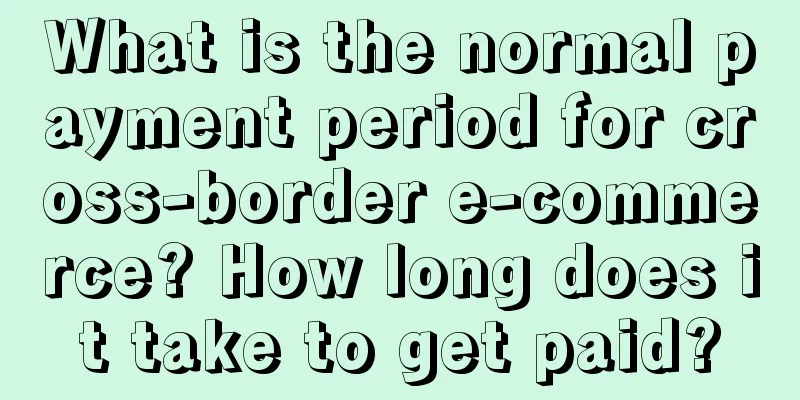What is the normal payment period for cross-border e-commerce? How long does it take to get paid?

|
With the progress of global economic integration, more and more companies choose to conduct international trade through cross-border e-commerce. However, a common problem in cross-border e-commerce transactions is the determination of the payment period. So, for cross-border e-commerce, what is the normal payment period? This article will discuss it from several aspects. 1. What is the normal payment period for cross-border e-commerce? Cross-border e-commerce platforms: Different cross-border e-commerce platforms may have different payment terms. Generally speaking, the payment terms of large platforms are relatively short, usually between 15 and 30 days. However, the payment terms of some small or emerging platforms may be longer, even exceeding 60 days. Payment method: Different payment methods will also affect the payment period of cross-border e-commerce. For example, the payment period of credit card payment is generally shorter, usually around 15 days, while the payment period of bank transfer or other offline payment methods may be longer. 2. How long does it take to get the money back? The payment time of cross-border e-commerce depends on many factors, such as payment method, platform policy, logistics time, etc. The following are some common payment times of cross-border e-commerce: Credit card payment: Generally, the payment can be received within 15 days. The specific time depends on the buyer's credit card issuing bank and payment channel. Bank transfer: Generally, the money can be returned within 30 days. The specific time depends on the buyer's bank and transfer method. Third-party payment: Generally, the payment can be returned within 7 to 15 days, and the specific time depends on the third-party payment platform and payment method. Platform settlement: Generally, the payment can be received within 15 to 30 days. The specific time depends on the platform's settlement policy and the seller's sales situation. It should be noted that the above payment time is for reference only, and the actual payment time may be affected by many factors. Sellers should understand the relevant regulations of the platform and payment methods before selling goods in order to make good financial planning and management. It is very important to determine the length of the cross-border e-commerce payment period through negotiation between the two parties and the specific situation. At the same time, the seller also needs to take corresponding measures to ensure the timeliness of the payment. There is no fixed standard for the normal length of the cross-border e-commerce payment period, but it is determined according to the actual situation and the needs of both parties. When determining the payment period, both parties should fully consider factors such as the order amount, the buyer's credibility, cultural differences, etc., and conduct reasonable negotiation and communication. Recommended reading: Which platform should I choose for my personal cross-border e-commerce business? What are the requirements for entry? How much does it cost for personal cross-border e-commerce? Do I need a deposit? Can cross-border e-commerce personal trademarks be registered? What are the regulations? |
<<: How to make money from Turkish cross-border e-commerce? What should you pay attention to?
Recommend
What is the Amazon blue badge? What is its function?
Many buyers on Amazon have discovered the existenc...
Pushing incentive policies, holding meetings one after another, Tik Tok and WeChat aggressively attack mini-games
The competition in the mini-game market is becomin...
How to increase traffic on Shopee? Traffic diversion strategies shared
Shopee has a large customer base, with over 200 mi...
How to pay a deposit on Shopee? What are the benefits?
Previously, you didn’t need to pay a deposit to op...
Can I still open a site if I can’t graduate from Shopee? How can I survive the incubation period?
After merchants join the Shopee platform, they can...
What are the pros and cons of tradekey? What is the best thing to sell?
Nowadays, there are many people doing foreign trad...
9700+ words super detailed package card drainage analysis (including templates and cases)
In daily life, everyone must have seen parcel card...
Game anchor travels around the world, gaining millions of followers with just one video
In the digital age, the influence of social media ...
Can't spend money on Xiaohongshu? There are too few bloggers in the category to cooperate with? How to solve these two problems!
Can't spend money on Xiaohongshu? There are to...
Takeaway lockers have started charging deliverymen, are they crazy?
This is the 1367th original article by Half Buddha...
Taobao begins testing "selected live broadcast rooms"
Recently, clothing merchants can have multiple sto...
2022 Mid-Autumn Festival Dunhuang.com Partial Business Adjustment Notice
Dunhuang.com announced a notice in early September...
How to calculate cross-border e-commerce shipping costs? What is the method?
Now more and more people are opening stores on cro...
With e-commerce blocked, TikTok turns to iQiyi, Youku and Tencent Video
This article introduces the development of TikTok,...
Generation Z loves trendy things! (Part 1)
From philately to cultural relics, people's lo...









